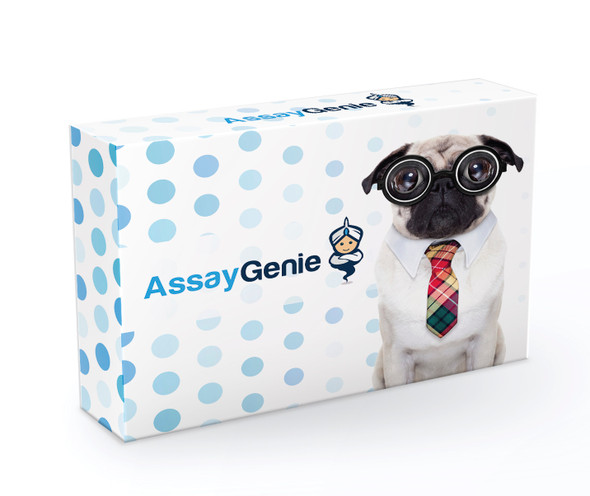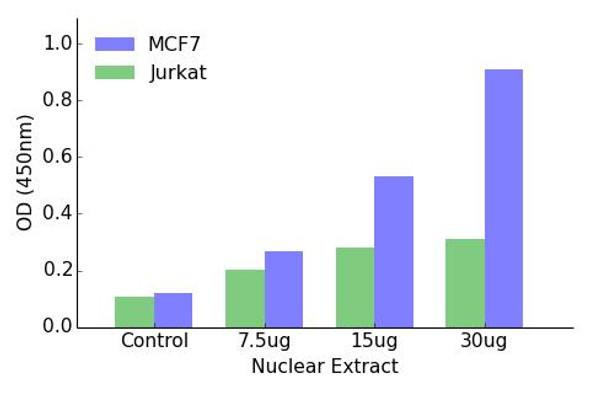Description
system_update_altDatasheet
| Product Name: | Fra-2 Transcription Factor Activity Assay |
| Product Code: | TFAB00078 |
| Target: | Fra-2 |
| Reactivity: | Human, Mouse, Rat |
| Sample Types: | Nuclear or cell lysates |
The Assay Genie Fra-2 transcription factor activity assay allows for the detection and qualitative analysis of endogenous levels of activated transcription factors in a variety of nuclear and cell lysates
Assay Genie ELISA kits are designed to significantly reduce experiment time and ensure sensitivity and flexibility for high-throughput screening.
| Assay Time: | 4.5 hours |
| Detection Method: | Colorimetric 450 nm |
| Size: | 12 x 8-Well Microstrips |
| Storage: | 4°C for 6 months |
| UniProt Protein Function: | FRA2: an oncogenic transcription factor of the bZIP family, Fos subfamily. The expression of Fos proteins is rapidly and transiently induced by a variety of extracellular stimuli including growth factors, cytokines, neurotransmitters, polypeptide hormones, and stress. Fos proteins dimerize with Jun proteins (c-Jun, JunB, and JunD) to form Activator Protein-1 (AP-1), a transcription factor that binds to TRE/AP-1 elements and activates transcription. Fos and Jun proteins contain the leucine-zipper motif that mediates dimerization and an adjacent basic domain that binds to DNA. The various Fos/Jun heterodimers differ in their ability to transactivate AP-1 dependent genes. In addition to increased expression, phosphorylation of Fos proteins by Erk kinases in response to extracellular stimuli may further increase transcriptional activity. Following growth factor stimulation, expression of FosB and c-Fos in quiescent fibroblasts is immediate but short-lived, while FRA1 and FRA2 expression persists longer. FRA2 and JUND up-regulate the expression of CCR4, MYB, MDM2, and BCL6, and are expressed at high levels in CCR4-expressing mature T-cell malignancies such as adult T-cell leukemia/lymphoma (ATLL) and cutaneous T-cell lymphomas (CTCLs). May play a role in regulating the transcription of ICOS downstream of TCR/CD28 and cytokine receptor signaling. Its transcription is significantly increased in metastatic clear cell renal cell carcinomas. Belongs to the bZIP family, Fos subfamily. Three isoforms of the human protein are produced by alternative splicing. |
| UniProt Protein Details: | Protein type:Transcription factor; DNA-binding Chromosomal Location of Human Ortholog: 2p23.3 Cellular Component: nucleoplasm; nucleus Molecular Function:protein binding; transcription factor activity Biological Process: cell death; regulation of transcription from RNA polymerase II promoter |
| NCBI Summary: | The Fos gene family consists of 4 members: FOS, FOSB, FOSL1, and FOSL2. These genes encode leucine zipper proteins that can dimerize with proteins of the JUN family, thereby forming the transcription factor complex AP-1. As such, the FOS proteins have been implicated as regulators of cell proliferation, differentiation, and transformation. [provided by RefSeq, Jul 2014] |
| UniProt Code: | P15408 |
| NCBI GenInfo Identifier: | 120487 |
| NCBI Gene ID: | 2355 |
| NCBI Accession: | P15408.1 |
| UniProt Secondary Accession: | P15408,Q6FG46, B2RD58, B3KP27, B4DYV4, |
| UniProt Related Accession: | P15408 |
| Molecular Weight: | 31,095 Da |
| NCBI Full Name: | Fos-related antigen 2 |
| NCBI Synonym Full Names: | FOS like 2, AP-1 transcription factor subunit |
| NCBI Official Symbol: | FOSL2 |
| NCBI Official Synonym Symbols: | FRA2 |
| NCBI Protein Information: | fos-related antigen 2 |
| UniProt Protein Name: | Fos-related antigen 2 |
| Protein Family: | Fos-related antigen |
| UniProt Gene Name: | FOSL2 |
| UniProt Entry Name: | FOSL2_HUMAN |






